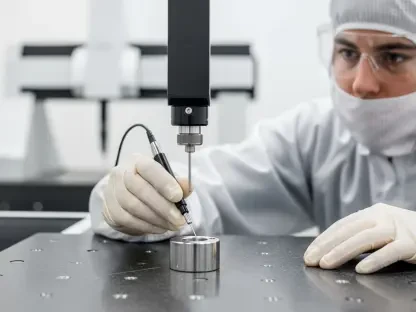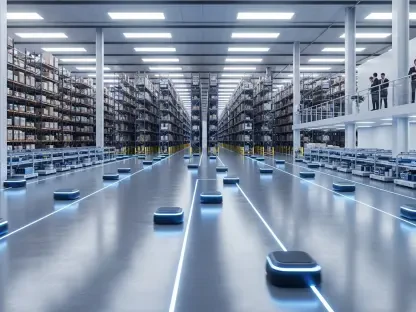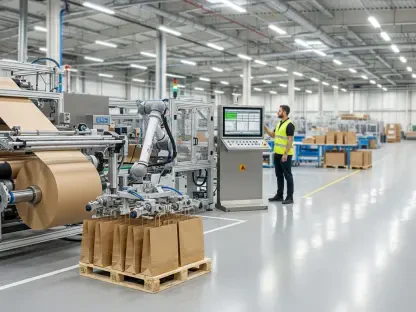Imagine a world where complex metal components for defense systems are produced in a fraction of the time traditional methods require, or where clean energy innovations like solid-state batteries are brought to market faster than ever before. This is not a distant dream but a reality being shaped by Binder Jetting technology, a transformative force in additive manufacturing. As industries face mounting pressure to innovate rapidly while maintaining precision and scalability, this technology stands out as a game-changer, offering solutions to high-stakes challenges in sectors ranging from defense to healthcare.
Core Principles and Emergence
Binder Jetting operates on a unique additive manufacturing principle, where a liquid binding agent is selectively deposited onto layers of powder material, binding particles together to form intricate structures. This layer-by-layer process allows for remarkable design freedom, creating geometries that would be impossible or cost-prohibitive with conventional methods. Its ability to work with diverse materials, including metals, ceramics, and polymers, positions it as a versatile tool in modern production environments.
The rise of this technology reflects a broader shift in manufacturing toward speed and adaptability. Unlike other 3D printing methods that often require slow, heat-intensive processes, Binder Jetting offers a faster alternative, particularly for high-volume production. Its growing relevance is evident in industrial landscapes where efficiency and material flexibility are paramount, paving the way for adoption across a wide array of applications.
Technical Features and Performance Analysis
High-Speed Production Capabilities
One of the standout features of Binder Jetting is its capacity for high-throughput manufacturing, enabling the rapid creation of complex parts at scale. Platforms like the Production System and X-Series, including the large-scale X160Pro machine, demonstrate impressive performance metrics in terms of speed and precision. These systems can produce intricate components significantly faster than many competing technologies, making them ideal for industries requiring quick turnaround times.
Beyond speed, the precision offered by these systems ensures that even the most detailed designs are executed with accuracy. This is particularly critical in applications where tight tolerances are non-negotiable, such as aerospace or defense components. The ability to maintain consistency across large production runs further solidifies Binder Jetting’s role as a reliable solution for industrial-scale manufacturing.
Material versatility also plays a key role in its performance. Whether producing metal parts for vehicles or polymer components for medical devices, the technology adapts to a range of production needs. This flexibility, combined with rapid output, underscores its potential to transform how industries approach prototyping and full-scale production alike.
Material Compatibility and Processing Dynamics
Binder Jetting’s compatibility with an extensive range of materials sets it apart from other additive manufacturing methods. From metals like aluminum to ceramics such as silicon carbide, and even production-grade polymers, the technology accommodates diverse industrial requirements. This broad material spectrum enables applications that span from robust defense hardware to delicate healthcare tools.
Post-processing techniques, particularly sintering, are integral to achieving the desired mechanical properties in finished parts. Sintering densifies the bound powder, enhancing strength and durability, which is essential for high-performance components. While this step adds to the production timeline, it ensures that the final products meet stringent quality standards necessary for critical applications.
The flexibility in processing also allows for customization based on specific project needs. Adjusting binder formulations or sintering profiles can optimize outcomes for unique material combinations, offering manufacturers a tailored approach. This adaptability is a cornerstone of Binder Jetting’s appeal, providing a pathway to innovation in material science and engineering.
Industry Innovations and Trends
Recent advancements in Binder Jetting technology highlight a trend toward integration with cutting-edge tools like artificial intelligence. AI-driven materials research is being leveraged to optimize material chemistries and geometries, significantly shortening development cycles from years to months. By employing digital twins and simulations, manufacturers can predict outcomes and refine processes with unprecedented accuracy.
Another notable trend is the move toward distributed research and development networks, often in collaboration with academic institutions. These partnerships facilitate innovation by connecting theoretical research with practical manufacturing hubs, accelerating the transition from prototype to production. Such collaborative models are proving effective in scaling solutions for real-world challenges.
Additionally, there is a strong push toward domestic manufacturing, driven by economic and security considerations. By reshoring critical production, industries aim to reduce reliance on foreign supply chains while bolstering national interests. This shift aligns with broader goals of enhancing competitiveness and safeguarding sensitive technologies, particularly in high-stakes sectors.
Real-World Impact and Applications
Binder Jetting has found significant traction in defense, with projects like a multi-million-dollar collaboration with the US Army to qualify aluminum components for ground vehicles. Partnerships with major contractors for silicon carbide optics in missile defense systems further illustrate its capacity to tackle complex engineering challenges. These initiatives showcase how the technology enables breakthroughs unattainable through traditional manufacturing.
In the clean energy sector, its applications are equally compelling, particularly in the production of solid-state battery components and transformer parts for grid modernization. The ability to create intricate designs with materials like sodium-ion compounds supports the development of sustainable energy solutions. This positions Binder Jetting as a key enabler in addressing global energy demands.
Healthcare is another area witnessing transformative impacts, with the technology facilitating the creation of customized medical devices and implants. Its precision and material flexibility allow for patient-specific solutions, improving outcomes in surgical and therapeutic contexts. These diverse use cases underscore the technology’s potential to address niche challenges across multiple industries.
Challenges in Adoption and Scalability
Despite its promise, Binder Jetting faces technical hurdles that can impede widespread adoption. Achieving consistent material density remains a challenge, often requiring extensive post-processing to meet performance standards. These complexities can drive up costs and limit scalability, particularly for smaller manufacturers with constrained resources.
Regulatory constraints also pose significant barriers, especially in defense applications where compliance with stringent standards is mandatory. Navigating these requirements demands substantial investment in certification and testing, which can slow deployment. Market dynamics, including financial restructurings within the industry, further complicate the path to broader acceptance.
Efforts to overcome these obstacles are underway, with strategic realignments focusing on innovation and efficiency. By addressing post-processing bottlenecks and aligning with regulatory frameworks, the industry aims to streamline adoption. These initiatives are crucial for ensuring that Binder Jetting fulfills its potential as a mainstream manufacturing solution.
Final Thoughts and Next Steps
Reflecting on the journey of Binder Jetting technology, it is clear that its integration of speed, material versatility, and advanced AI tools has redefined additive manufacturing. The technology has proven its worth in critical sectors like defense, energy, and healthcare, delivering solutions that traditional methods struggle to match. Its impact on domestic production has also laid a foundation for enhanced economic and security outcomes.
Looking ahead, the focus should shift to addressing persistent technical challenges through collaborative innovation. Streamlining post-processing and reducing costs will be essential for broader market penetration. Industry stakeholders must prioritize partnerships that bridge research and application, ensuring that emerging solutions are both practical and scalable.
Furthermore, policymakers and manufacturers should advocate for supportive frameworks that ease regulatory burdens while maintaining safety and quality standards. Investing in workforce training to handle advanced systems will also be critical for sustaining growth. By tackling these areas, Binder Jetting can solidify its role as a cornerstone of modern manufacturing, driving progress in high-impact domains for years to come.









